Core3duino
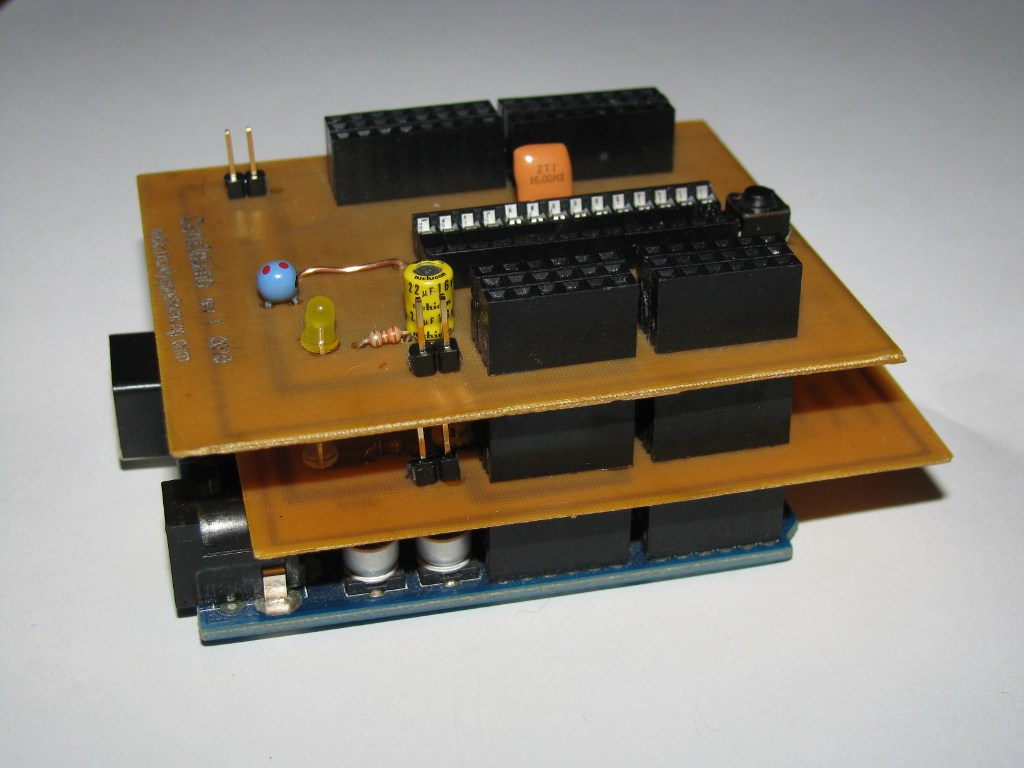
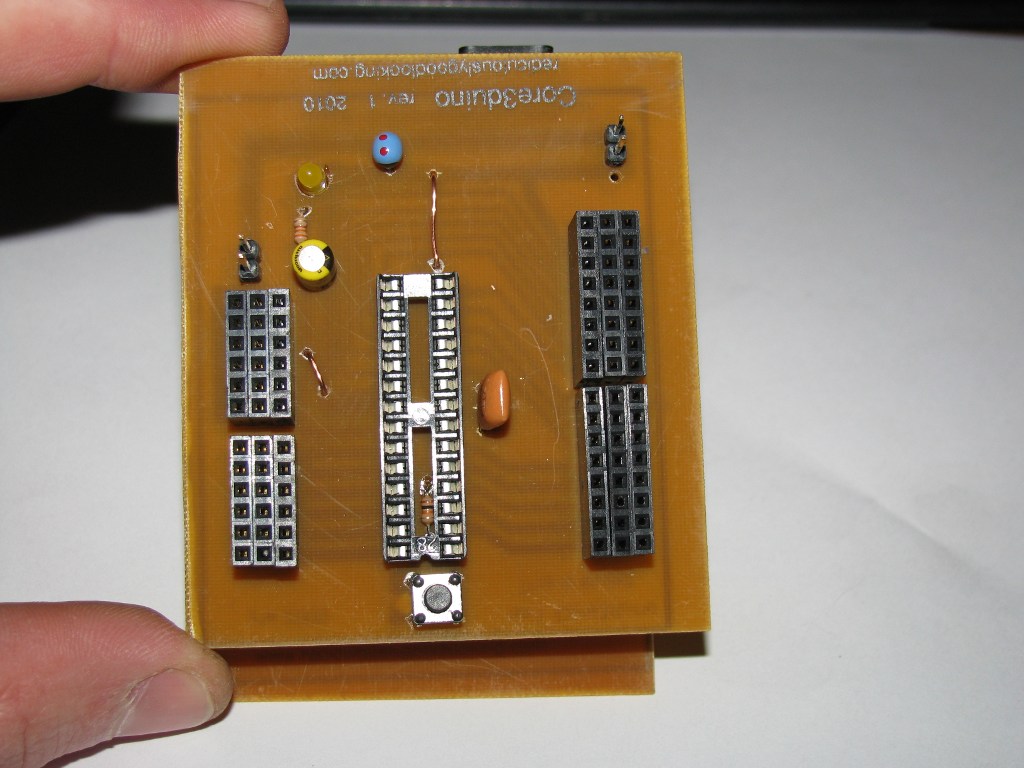
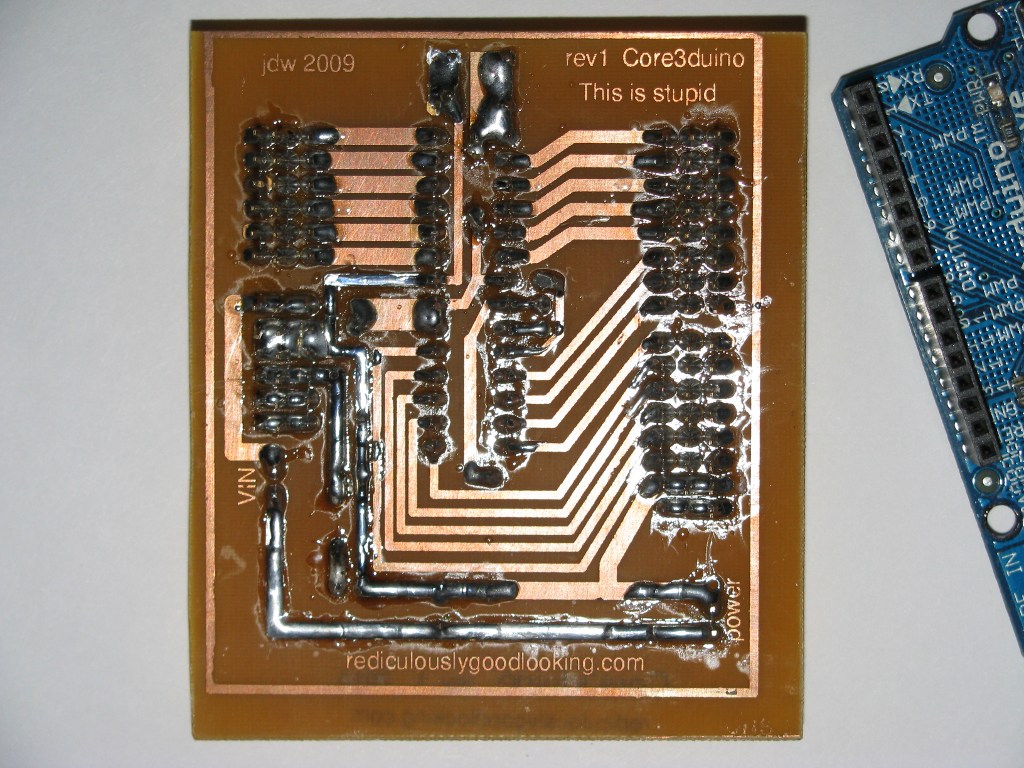
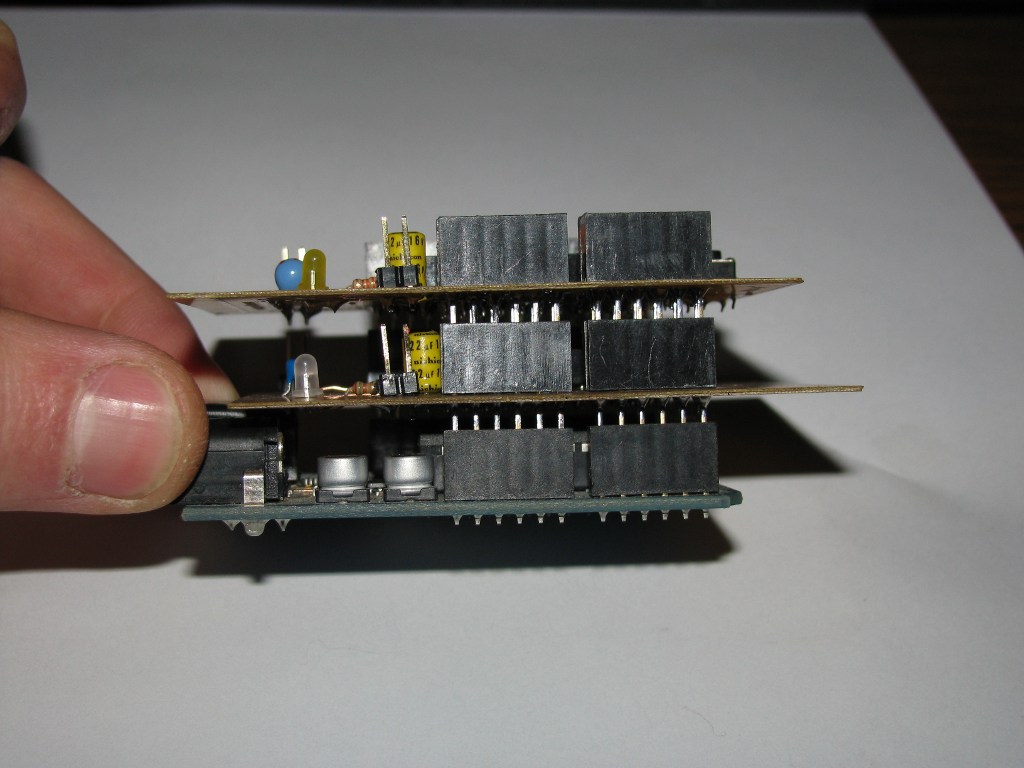
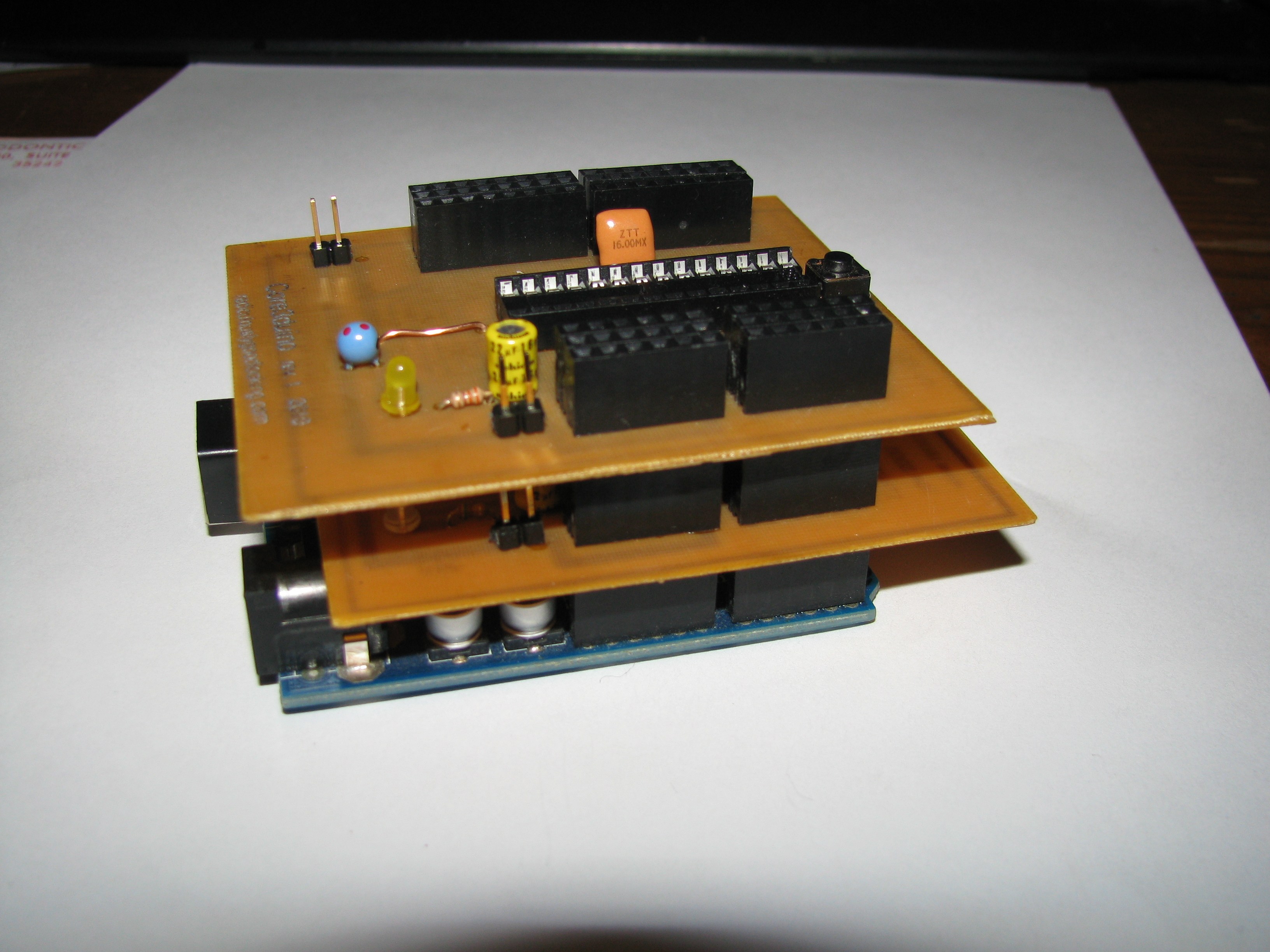
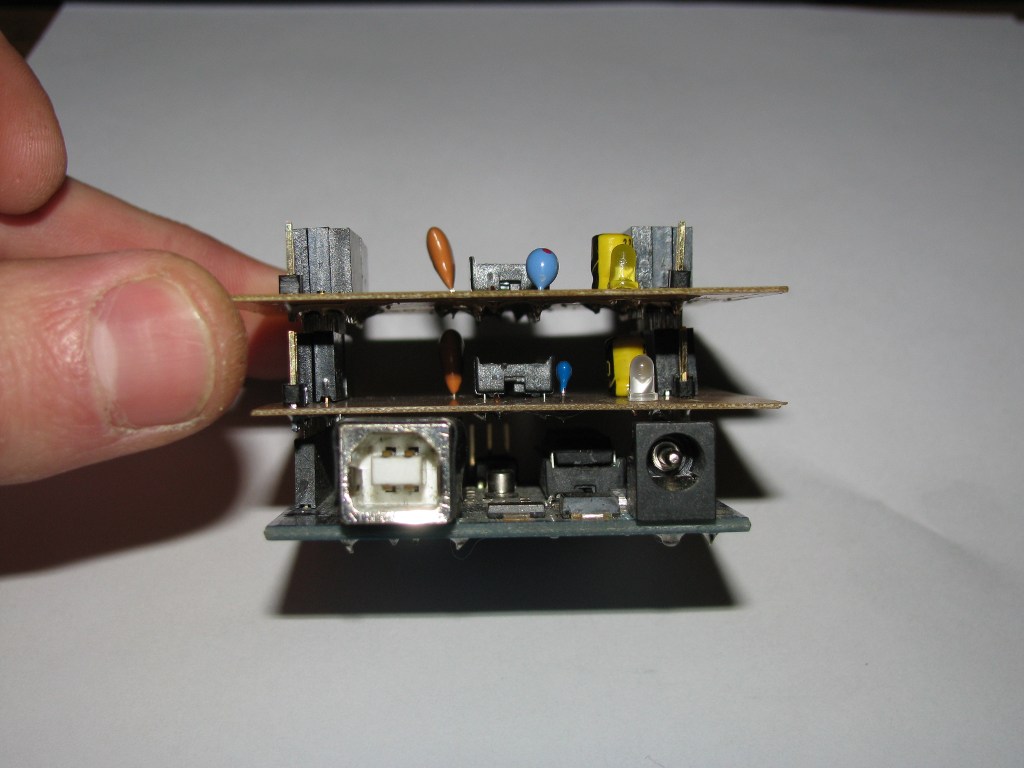
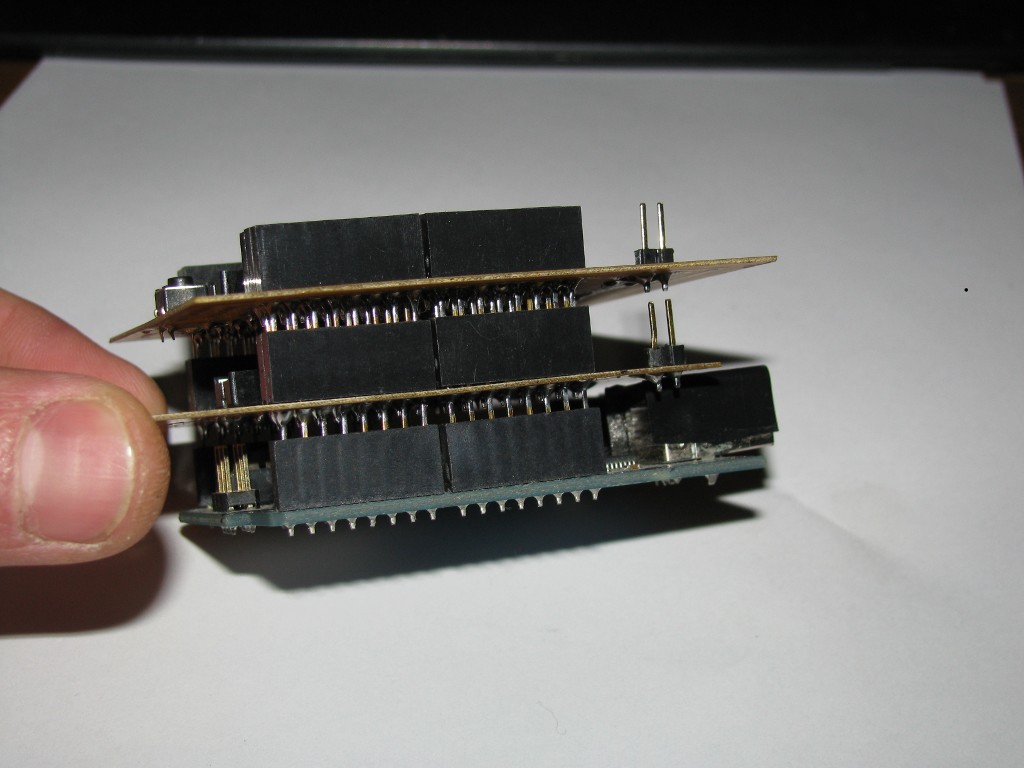
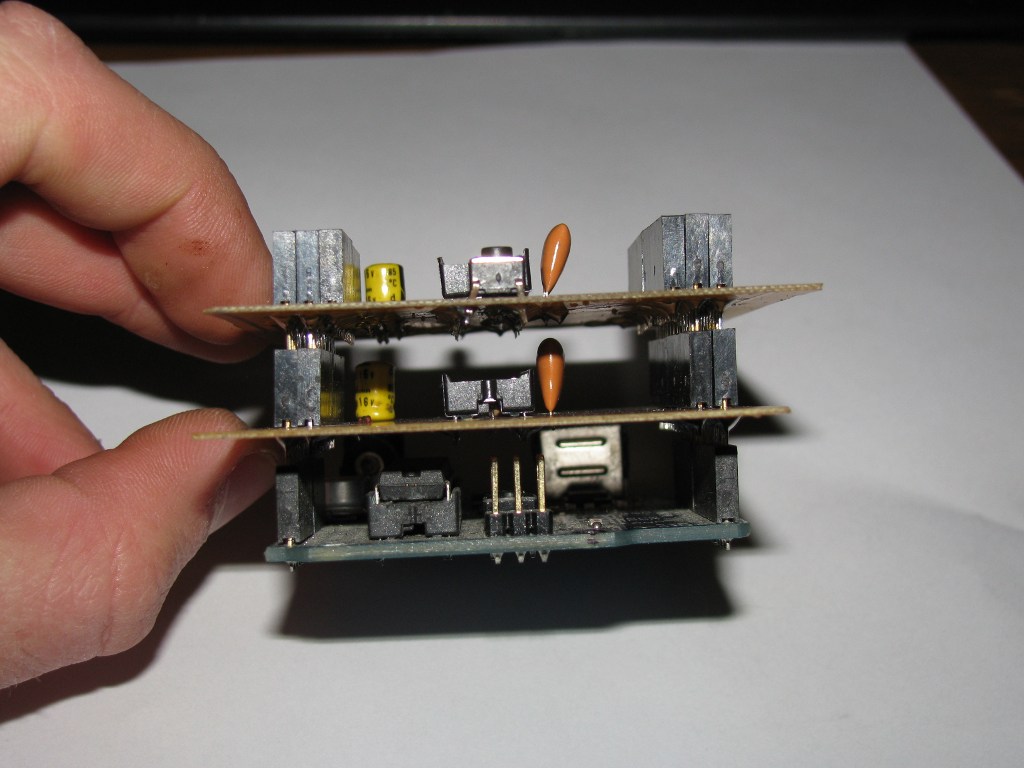
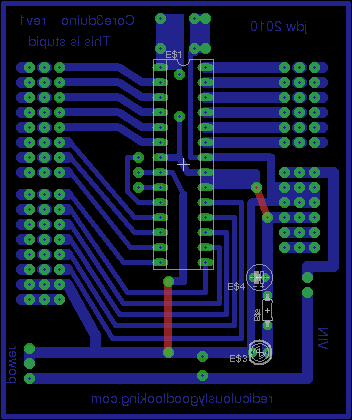
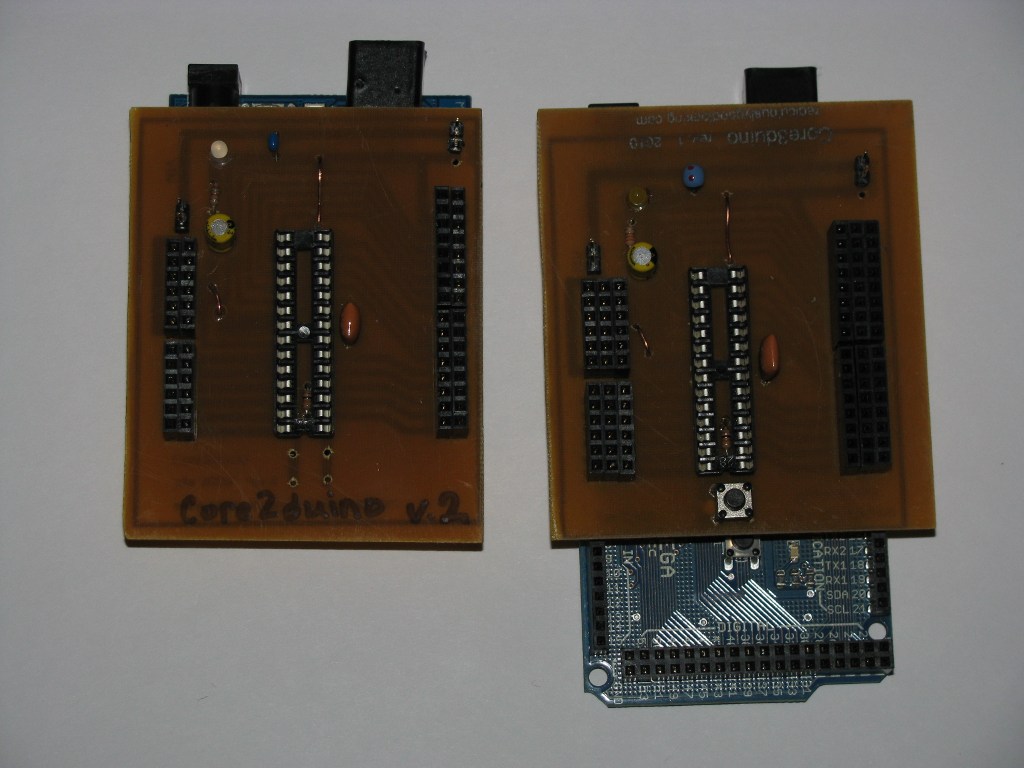
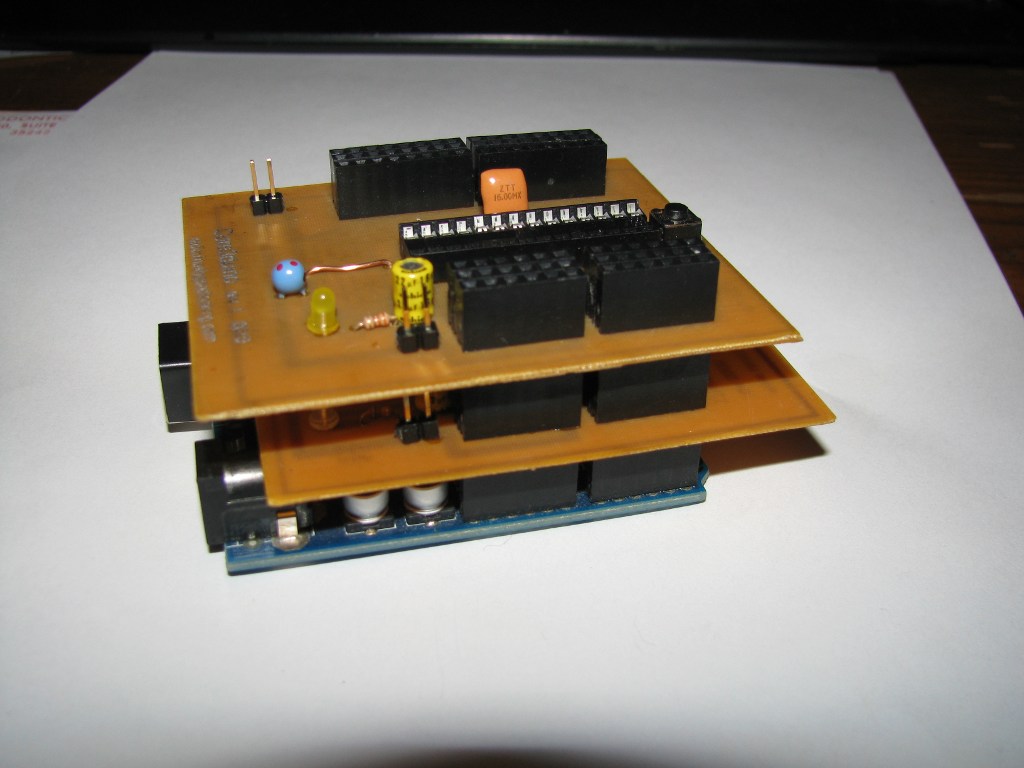
This is an addon shield to an addon shield. That's right, you have to have the Core2duino on your Arduino to be able to understand why you would want this in the first place. So once you have your Core2duino saddled up, give this one a shot (you don't technically have to have the core2duino to use this with your arduino or standalone, but only pins that are plugged in will work).
It will fit on any Arduino (including Mega) and allows for an additional shield to be added on top (shield will be connected to the base Arduino) other pins will be free.
It can be powered via the Base Arduino or the VIN pins - power will be routed through the VIN pin from base Arduino and back out as +5v to Core2/3duino.
Why do this? well, the short answer is - why not? You end up with:
3 separate processors
60 input/output of which:
24 digital I/O pins
18 pwm pins
18 analog inputs
including 6 external interrupts
...all for about $25 more than your Arduino. (about $10-12 each)
Anyways, it only took about an hour to modify the Core2duino Eagle file into this.
This is a fun project to try and the .brd file has adequate spacing for ease with etching.
Most of these instructions are very similar to the Core2duino... differences are noted.
I will be happy to help if anyone has questions.
The next version is likely to have an FTDI programming cable connection for easy in system programming.
It will fit on any Arduino (including Mega) and allows for an additional shield to be added on top (shield will be connected to the base Arduino) other pins will be free.
It can be powered via the Base Arduino or the VIN pins - power will be routed through the VIN pin from base Arduino and back out as +5v to Core2/3duino.
Why do this? well, the short answer is - why not? You end up with:
3 separate processors
60 input/output of which:
24 digital I/O pins
18 pwm pins
18 analog inputs
including 6 external interrupts
...all for about $25 more than your Arduino. (about $10-12 each)
Anyways, it only took about an hour to modify the Core2duino Eagle file into this.
This is a fun project to try and the .brd file has adequate spacing for ease with etching.
Most of these instructions are very similar to the Core2duino... differences are noted.
I will be happy to help if anyone has questions.
The next version is likely to have an FTDI programming cable connection for easy in system programming.
What You Need to Get Started
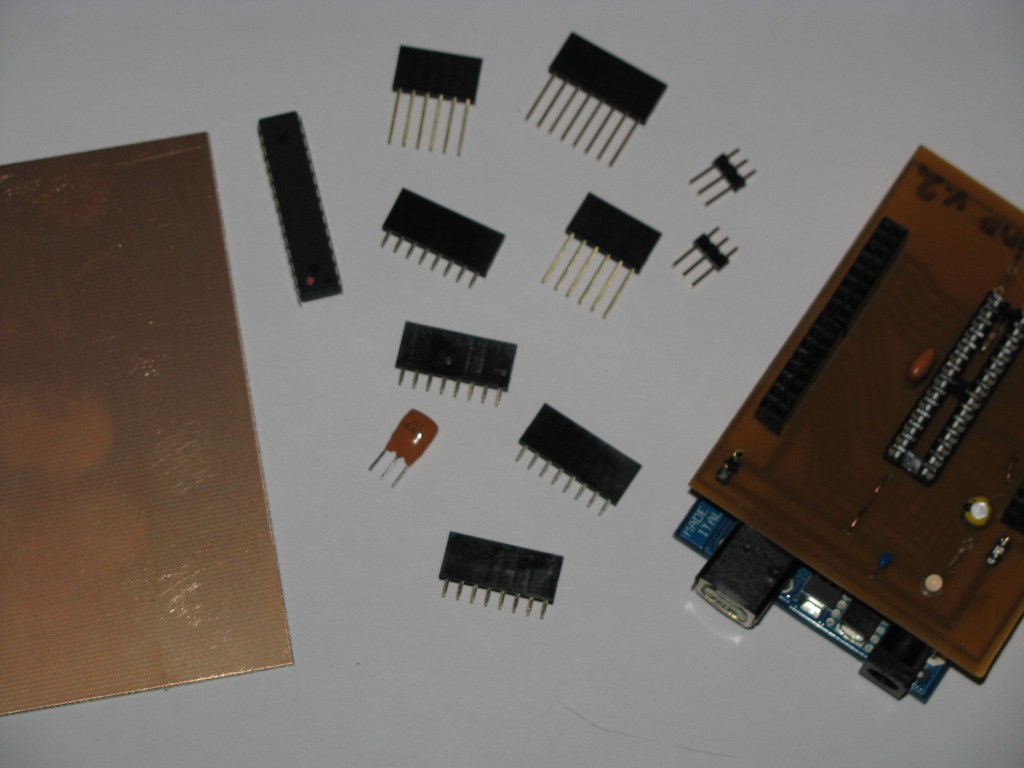
Core3duino:
1. (1)pc copper clad (3"x4") or assortment
2. (1) 28-pin dip socket
3. 16 mHz crystal resonator w/ built-in capacitor
4. An Atmega168 with Arduino bootloader
5. (2) stackable header set
6. (2) 6-pos female headers (2) 8-pos female headers .1"
7. (4) male pin headers (optional) .1"
Other things needed:
power LED, any size/color
330 ohm-1k ohm resistor for power led
10k resistor for reset button
reset button
.1uf capacitor optional
16v 22uf-220uf capacitor optional
Acetone
etchant solution (muriatic acid + hydrogen peroxide)
paper towels
scotch brite pads
iron
Laser Printer
magazine paper
rubber gloves
aquarium bubbler
1. (1)pc copper clad (3"x4") or assortment
2. (1) 28-pin dip socket
3. 16 mHz crystal resonator w/ built-in capacitor
4. An Atmega168 with Arduino bootloader
5. (2) stackable header set
6. (2) 6-pos female headers (2) 8-pos female headers .1"
7. (4) male pin headers (optional) .1"
Other things needed:
power LED, any size/color
330 ohm-1k ohm resistor for power led
10k resistor for reset button
reset button
.1uf capacitor optional
16v 22uf-220uf capacitor optional
Acetone
etchant solution (muriatic acid + hydrogen peroxide)
paper towels
scotch brite pads
iron
Laser Printer
magazine paper
rubber gloves
aquarium bubbler
Download and Print the Eagle File

You need a Laser printer. Don't try it with an Inkjet as it will not work. I have heard bad things about Brother laser printers using strange toner that doesn't transfer to copper, but I use a Brother 7020 and it works great. I have tried several different types of magazine paper and i'm sure that most will work, but if in doubt, use Cosmopolitan.
1. Download the .zip file and EagleCad if you don't already have it.
2. Unzip the .zip file to your computer.
3. Open the .brd file with Eagle.
4. Select the "Layers" option and de-select the "top" layer, leaving the other options as they are.
5. Select Print, make sure you check the boxes "Black" and "Solid" under Options. Then Print to magazine paper.
Carefully cut the printed design to the size of your copper clad. Use a razor blade or scissors, just be sure not to touch the toner with your fingers.
1. Download the .zip file and EagleCad if you don't already have it.
2. Unzip the .zip file to your computer.
3. Open the .brd file with Eagle.
4. Select the "Layers" option and de-select the "top" layer, leaving the other options as they are.
5. Select Print, make sure you check the boxes "Black" and "Solid" under Options. Then Print to magazine paper.
Carefully cut the printed design to the size of your copper clad. Use a razor blade or scissors, just be sure not to touch the toner with your fingers.
Downloads
Transfer to Copper Clad Pcb
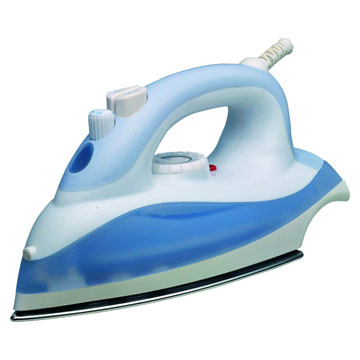
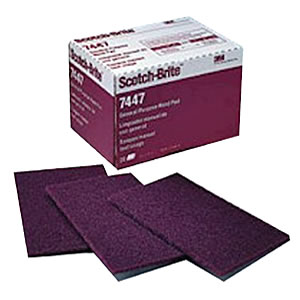
These are the generic instructions that I follow anytime I etch my own PCB's:
You need an Iron, a Scotch-brite pad, a few paper towels, and some Acetone.
Before you start, plug in your iron and turn on to highest setting.
1. scrub copper clad with a scotch-brite pad until shiny
2. use acetone on a paper towel to wipe off copper dust from copper clad
3. repeat step 2 until there is NO visible dust being removed, folding the paper towel after each wipe. re-apply acetone as needed. If you don't get ALL the dust off, it will not transfer.
4. Let dry for a few minutes.
5. pre-heat the copper clad with the iron for a minute or so, using a freshly removed piece of magazine paper (the less pictures the better) between the iron and copper clad.
6. remove iron, and CAREFULLY place print onto the copper and press it down.
7. add another piece of magazine paper between your print and the iron to keep from ripping the print.
8. Press hard with iron, moving every 30 seconds for about 3 minutes.
9. remove iron and let cool for 10 minutes.
10. place in container with warm soapy water for 20 minutes to dissolve paper.
11. remove paper with thumb, scrubbing it until it is all gone and there is only toner left.
12. If you have any smeared tracks, clean them up with a small flat-head screwdriver. If you scrape too much away, use fingernail polish to add some more "toner" where needed.
on to etching...
You need an Iron, a Scotch-brite pad, a few paper towels, and some Acetone.
Before you start, plug in your iron and turn on to highest setting.
1. scrub copper clad with a scotch-brite pad until shiny
2. use acetone on a paper towel to wipe off copper dust from copper clad
3. repeat step 2 until there is NO visible dust being removed, folding the paper towel after each wipe. re-apply acetone as needed. If you don't get ALL the dust off, it will not transfer.
4. Let dry for a few minutes.
5. pre-heat the copper clad with the iron for a minute or so, using a freshly removed piece of magazine paper (the less pictures the better) between the iron and copper clad.
6. remove iron, and CAREFULLY place print onto the copper and press it down.
7. add another piece of magazine paper between your print and the iron to keep from ripping the print.
8. Press hard with iron, moving every 30 seconds for about 3 minutes.
9. remove iron and let cool for 10 minutes.
10. place in container with warm soapy water for 20 minutes to dissolve paper.
11. remove paper with thumb, scrubbing it until it is all gone and there is only toner left.
12. If you have any smeared tracks, clean them up with a small flat-head screwdriver. If you scrape too much away, use fingernail polish to add some more "toner" where needed.
on to etching...
Etch Copper Board
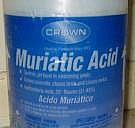
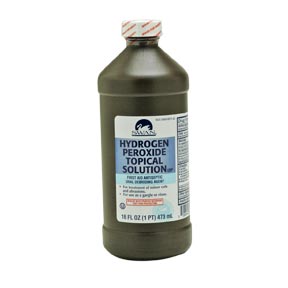
Make a good etching solution:
use 1 part Muriatic Acid (I bought a gallon at Sherwin Williams paint store for $12) to 2 parts Hydrogen Peroxide (the kind you buy at the Pharmacy for $2 a bottle). Always add acid AFTER adding Hydrogen Peroxide.
Use rubber gloves so you don't get burned by the acid.
You only need about 2 cups to etch this size board. It helps if you have an aquarium bubbler and some extra hose to place under the copper while it is etching, as this greatly speeds up the process.
1. mix solution (2 parts hydrogen peroxide, 1 part muriatic acid), and put into plastic container
2. place copper clad into etchant.
3. use bubbler to speed things up
4. when you see that the copper is completely gone, pull it out and wash off with water (outside).
The toner should still be there, and now you can wipe it off with a paper towel and some more Acetone.
Now you should have a copper circuit left, ready to drill holes in.
use 1 part Muriatic Acid (I bought a gallon at Sherwin Williams paint store for $12) to 2 parts Hydrogen Peroxide (the kind you buy at the Pharmacy for $2 a bottle). Always add acid AFTER adding Hydrogen Peroxide.
Use rubber gloves so you don't get burned by the acid.
You only need about 2 cups to etch this size board. It helps if you have an aquarium bubbler and some extra hose to place under the copper while it is etching, as this greatly speeds up the process.
1. mix solution (2 parts hydrogen peroxide, 1 part muriatic acid), and put into plastic container
2. place copper clad into etchant.
3. use bubbler to speed things up
4. when you see that the copper is completely gone, pull it out and wash off with water (outside).
The toner should still be there, and now you can wipe it off with a paper towel and some more Acetone.
Now you should have a copper circuit left, ready to drill holes in.
Drill Holes
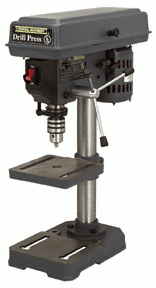
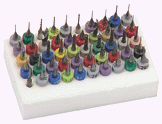
Now you need to drill the holes in the copper clad board. I recommend using a Drill press, but if you don't have one, a regular drill will work. Try not to cut through any of the traces with the drill bit, as that will make it harder to solder.
This micro carbide drill bit set from Harbor Freight is excellent for the price, as well as a nice drill press if you don't already have one.
Now after you get all those little holes drilled, on to soldering.
This micro carbide drill bit set from Harbor Freight is excellent for the price, as well as a nice drill press if you don't already have one.
Now after you get all those little holes drilled, on to soldering.
Solder

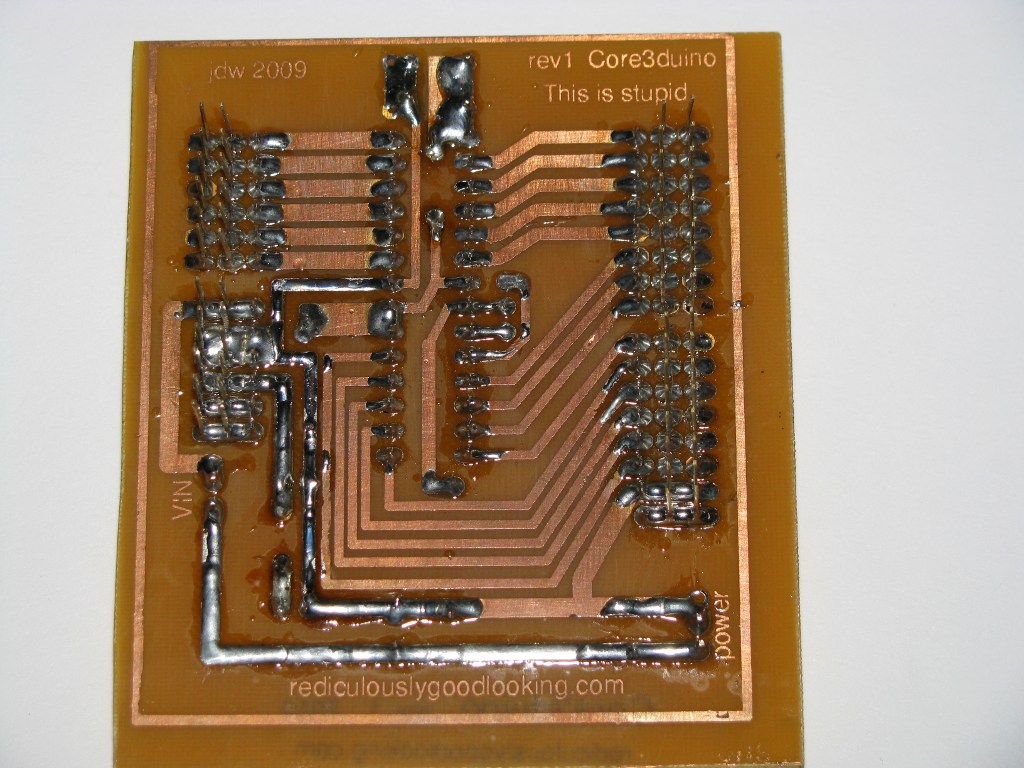

Please refer to the pictures below for placement of parts. I can offer a more detailed diagram if anyone is interested.
Note that there are 2 red lines on the Eagle .brd file. These are power traces and need jumper wires placed where the red lines are.
I started by soldering the stackable headers first (center headers, then inside, then outside), since they are slightly harder to access with the soldering iron.
The 3 holes next to the IC are for the 16mHz resonator and it can go in either way (middle pin is ground, so it doesn't matter)
Then I add the female headers. Next the male pin headers. It is helpful to install these with a jumper holding them to an adjacent header pin, so you don't have to hold them while soldering.
Power LED and resistor next, then the 28-pin socket and power screw-terminals.
Then the 10k pull-up resistor for the reset button as well as the button.
Remember the 2 jumper wires.
There are not that many parts on this board and other than the capacitors and power LED, you don't have to worry about polarity while placing the components (you need to plug the IC's in correctly when you are done, but the sockets can go in either way).
Remember, when soldering, to heat the contacts and let the solder melt onto it. If you try to heat the solder directly, you might end up with a big mess.
Note that there are 2 red lines on the Eagle .brd file. These are power traces and need jumper wires placed where the red lines are.
I started by soldering the stackable headers first (center headers, then inside, then outside), since they are slightly harder to access with the soldering iron.
The 3 holes next to the IC are for the 16mHz resonator and it can go in either way (middle pin is ground, so it doesn't matter)
Then I add the female headers. Next the male pin headers. It is helpful to install these with a jumper holding them to an adjacent header pin, so you don't have to hold them while soldering.
Power LED and resistor next, then the 28-pin socket and power screw-terminals.
Then the 10k pull-up resistor for the reset button as well as the button.
Remember the 2 jumper wires.
There are not that many parts on this board and other than the capacitors and power LED, you don't have to worry about polarity while placing the components (you need to plug the IC's in correctly when you are done, but the sockets can go in either way).
Remember, when soldering, to heat the contacts and let the solder melt onto it. If you try to heat the solder directly, you might end up with a big mess.
Play!
Now you are ready to use your Core2duino.
Upload some code and see if it works!
I have written a test sketch that turns all digital pins on and back off to test them. Upload the sketch to both Atmega168 chips and check to make sure all pins get power on both chips.
Once you establish that it works, put your thinking cap on and build something that requires 40 I/O pins and then message me and tell me about it!
Upload some code and see if it works!
I have written a test sketch that turns all digital pins on and back off to test them. Upload the sketch to both Atmega168 chips and check to make sure all pins get power on both chips.
Once you establish that it works, put your thinking cap on and build something that requires 40 I/O pins and then message me and tell me about it!